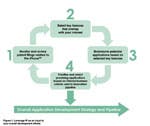
With the iPhone user base rapidly increasing and the App Store recently surpassing 2 billion downloads, the market for new applications continues to look extremely favorable. However, this rapidly expanding platform presents some interesting challenges to developers.
Leverage IP as an input to your overall development efforts

- The first challenge is to quickly develop and deploy new applications that capitalize on near-term opportunities created by incremental improvements in the device or the OS, or the changing interests of the user base.
- The second challenge is to develop new applications that take advantage of next generation capabilities and provide for a first mover advantage.
While each challenge is different from a business and technical standpoint, solutions to both challenges can be addressed by systematically examining filed patents and published applications, and using this data to support your development efforts.
Publicly available intellectual property
One of the most overlooked inputs to innovation for inventors and developers are different forms of publicly available intellectual property (IP), such as patent applications, issued patents, and extensions thereof. A patent represents an exclusive right, granted to an assignee, preventing others from making, using, or selling the invention without the assignee’s permission. One of the requirements in obtaining this right includes describing the invention in a manner that would allow someone in the industry or field to re-create it using the inventor’s “footsteps.” It is important to note that filing patents are agnostic to any particular industry or size of company. Anyone can file a patent including a single individual inventor.
As you might expect, Apple is very active in filing patents, with approximately 250 filings protecting features of the iPhone. For developers, this information represents a great opportunity to discern potential capabilities that may be built into future generations of the iPhone. Using this information, developers can design applications based on this anticipated functionality. IP-savvy companies and inventors, like Apple, will typically file applications prior to releasing new products, so that the product is better protected when it goes to market.
Steps to leveraging IP
With this in mind, the following are some steps that developers can take to leverage IP as an input into innovation and application development efforts:
- Study patent filings related to the iPhone
Of all the steps to be discussed, this may be the easiest. There are numerous Web sites that actively follow technology developments related to the iPhone and they regularly highlight when new filings are published (note that new applications filed through the USPTO are typically not published until 18 months after their date of filing). A quick Web search for iPhone in the last two months reveals several, including the following assigned to Apple:
- US20090215497, “Transitional Data Sets,” which describes a dynamic or transitional set of applications that could be displayed to a user based on their location as determined by GPS, Wi-Fi, cellular communication, etc.
- US20090169070, “Control of electronic device by using a person’s fingerprints,” which describes a method and system for assigning specific commands based on the user’s fingerprints (i.e. a separate command can be assigned for your index finger vs. thumb)
- US20090209240, “Auto messaging to currently connected caller,” which describes an application which allows a user to compose a message or send a file from the mobile device to the other connected party based on the caller details.
- Select key features that overlap with your interest
Based on the patent filings above, it is clear that Apple is going through the internal process of considering possible features for the iPhone (and other new products like the much anticipated tablet device) and systematically documenting these features. Given your resources, it likely makes sense to focus on an area that overlaps your interests. For instance, if you have particular expertise with applications that take advantage of touch screen technology, new features, such as those described in US20090169070 above, may be a great source of innovation. Additionally, as Apple has demonstrated a strong commitment to the use of touch screen technology, it is expected that this will continue to be an area of continued technology advancement for future iPhones.
- Brainstorm potential applications based on features
Brainstorming is often more difficult than anticipated for developers and inventors. The most effective brainstorming employs a systematic process with defined starting points and a set of boundaries to direct invention. We recommend using the patent literature to develop a set of criteria to guide development efforts.
The background of the invention and the detailed description are rich sources of information that identify specific issues or problems overcome by the new invention. In the case of US20090169070, issues addressed by this invention include ability to better interact with the device during certain activities (i.e. running) or providing the visually impaired with increased ability to utilize iPhone functionality. Given this, applications can now be framed around particular issues or markets relevant to the new technology.
- Prioritize and develop new applications
Typical brainstorming sessions usually result in a multitude of new application possibilities, so having predefined criteria for selecting the most promising ideas is critical. Common criteria include: market, expected cost to develop, timeline for implementation, and opportunity for subsequent versions. Once you have tested each of your ideas against criteria aligned with your goals, you will be in a position to proactively develop applications ahead of competitors.
Keep your “idea pipeline” full
The pace at which new applications are being developed suggests that the most successful developers (and development companies) will have a process in place to keep their application “idea pipeline” full. Patent filings are a great source of innovation and should be considered as an input to help guide your innovation and development efforts.

